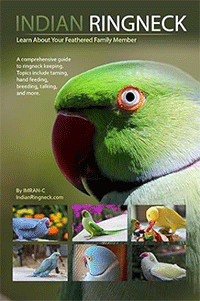Hello Totty,
First of all, let me welcome you to our forum and I commend you for doing your research on such complex creatures. We are a fun-loving bunch here from our mods to our users.
So, I know you had a lot of questions regarding your new ringneck. This is normal and I'll start off with the leg band first.
There is no rhyme or reason to breeders band's numbers. In fact, all my band numbers are randomly generated and I keep records for myself. Unfortunately, your little monster has been through home after home so it might be more difficult finding his original breeder. Nonetheless, continue to do a Google search and perhaps you might get a clue as to where his breeder might be. So, in conclusion I would not worry too much about where he was bred as it might lead to a dead end.
Also, you had mentioned that he was once tame and was talking. Correct? If so, the ball is in your court. I know many people believe that ringnecks need constant handling to maintain their tameness. In my opinion this is not the case. When I am traveling, or gone for long periods, my ringnecks are so excited to see me they go through their vocabulary, and pin eyes, and want nothing more than to be held and petted by me.
So why is your ringneck scared? It could be that the ringneck was abused from home to home or it could be that he needs time to adjust to his new environment and surroundings. Thankfully, if he was abused, it is now obvious he has come into a wonderful home and hopefully his permanent home. You should keep in mind that ringnecks are noisy and messy. But it's well worth the effort!

So right now it's clear that he is showing signs of fear when you try to handle him. What I would do is start a positive reinforcement program immediately. Basically, positive reinforcement is helping the ringneck understand that the behavior you want will be rewarded. It's an amazing training technique and I use it with my birds. Believe it or not, even my most tamest birds have their days where they don't want to be petted or handled and I give them their space. As much as I hate to compare parrots to people, they have different personalities and moods like we do.
Because he is older I would definitely use positive reinforcement to train him to step up. First, start with the perch and ask them to step up. It's important you gently move the perch towards him and avoid fast movements in the beginning. Gently take the perch and touch his breast until he decides to step up. Reward him with food and continue the process daily. Over time, he will become comfortable and look forward to this game.
Once he has mastered this, while he is on the perch, take a few steps back away from the cage and reward him. In the beginning, he might want to flutter back to his cage and that's okay. This needs to be practiced daily until you are able to take the bird anywhere you need on the perch. When he is comfortable and has mastered this, you can start hand taming.
Hand taming should begin by taking the bird to a quiet room and asking him to step up like the perch. In the meantime, while he is learning to step up on your hand, you should start incorporating the parrot into your life. Things such as eating, placing him on a perch near the sink while you shower, or reading are great ways to do this. The more you keep the ringneck around you the more he will come to accept you as his flock mate.
Don't feel jealous about other ringneck owners. You are in for a wonderful journey and success is even more sweet when you've put your hard work and effort into taming your little guy. Besides, there's no need to rush things as many ringnecks can reach into their mid-20s.
I can't wait to hear your progress so please keep us updated!

Best wishes,
IMRAN-C
